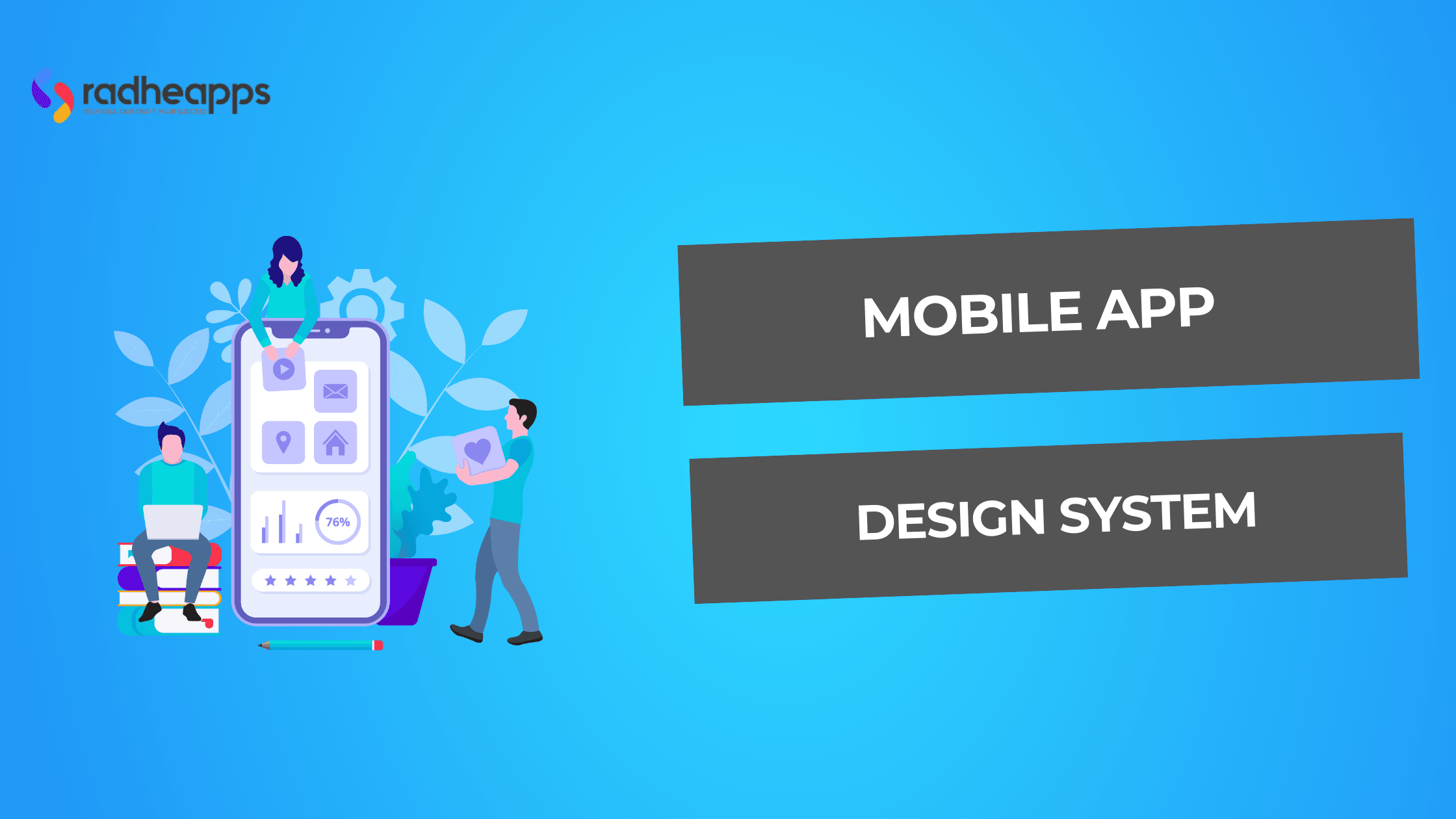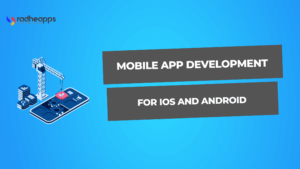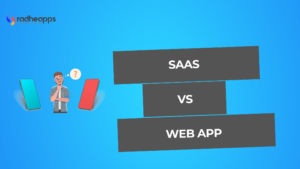The clustered home screen with tiny text, the overlapped buttons, and the zero visual hierarchy led him to leave the app immediately, unconsciously. It is the story of every average mobile app user if you serve them a poor app design experience.
The design of mobile application user interfaces is critical in mobile application development because it creates interfaces with excellent aesthetics and efficient usability.
The rising use of mobile phones for digital access makes user interface design quality more vital than ever. Well-designed user interfaces make features and functionalities accessible, enabling users to achieve better satisfaction and stay loyal to apps.
If your in-house team of designers has already developed a successful mobile app and is well aware of what the current user demands to stay on the app for a longer period, you can build it yourself. Radhepps has developed thousands of applications so far (4400 to be precise.)
We are familiar with the fact that an app is not something like you just throw every possible feature in the hopes of attracting an audience; it is more about building such a design that makes the user stay longer inside the app. It does not mean we cut the number of features; it means we add features that are designed for greater ROI to meet the exact user’s needs.
Book a call with us to see how all of this is going to create an app that makes the user to stay inside for longer period of time.
What Is Mobile App UI Design?
Mobile application User Interface (UI) design requires developers to establish the visual and interactive contact points that people use when working with mobile applications.
Importance of UI in Mobile Apps
A well-designed UI is essential for mobile apps because of the following:
- First Impressions: The UI is the first impression users have. A minimalistic and logical design makes a good impression.
- Improved Usability: Logical designs and intuitive interactions enhance usability, making it easy for users to navigate.
- Improved Engagement: A good UI engages users to play around with features and spend more time on the app, which improves retention rates.
- Accessibility: Effective UI design provides equality to various categories of users, including the disabled.
Key Differences Between UI and UX
UI (User Interface) and UX (User Experience) are closely connected yet different concepts:
| Aspects | UI Design | UX Design |
| Focus | Visual and interactive elements of an interface | Overall user journey and experience |
| Key Activities | Aesthetic design (colors, typography, buttons) | Problem-solving and logical structure |
| Objective | Designing screens, layouts, and interactive components | Ensuring ease of use and satisfaction |
| Examples Analogy | Painting the visible part of a house | Designing the house’s structure and layout |
Core Principles of Mobile App UI Design
Check out these four principles and master them to get your basics on point:
Ensure Simplicity and Clarity
- Minimalism: Ditch the unnecessary features and concentrate on the bare essentials to keep the app uncluttered. A tidy interface helps users grasp and use the app instantly.
- Clear Visual Hierarchy: Employ size, color, contrast, and whitespace to focus on the crucial elements.
- Ease of Use: Refrain from overwhelming users with complicated layouts or too many options, making the experience seamless.
Prioritize User-Centric Navigation
- Intuitive Navigation Patterns: Use familiar navigation patterns such as tab bars, hamburger menus, and swipe gestures to navigate easily.
- Feedback Mechanisms: Offer visual or auditory feedback on user actions, such as button presses or loading spinners, to validate interactions.
Maintain Visual Consistency
- Uniform Design Language: Implement consistent typography, color schemes, icons, and layouts on all screens to have a harmonious experience.
- Brand Identity: Make the design consistent with the branding of the app while keeping the style and tone consistent throughout the interface.
- Predictability: Consistent patterns minimize the learning curve and make users feel at ease while using the app.
Utilize Responsive and Adaptive Design
- Device Flexibility: Create interfaces that adapt smoothly to various screen sizes, orientations, and resolutions for the best possible experience on any device.
- Touch-Friendly Features: Make sure buttons and interactive elements are sized correctly for touch inputs on mobiles.
- Cross-Platform Consistency: Keep mobile and desktop app versions consistent for a cohesive user experience.
How to Design an Intuitive Mobile App UI
To develop an intuitive mobile app, you need to keep several factors in mind. Here are four of them:
Choose the Right Color Palette and Typography
- Color Palette: Pick colors that reflect your brand identity without compromising readability and accessibility. Apply contrasting colors to text and background to enhance visibility.Darker shades as headings and lighter shades as body text provide a clean contrast, for instance.
- Typography: Select readable fonts that resize well on various devices. Hierarchy through font sizes for headings, subheadings, and body text to lead users through the material. Responsive typography makes the text easily readable on different screen sizes.
Create a Seamless Navigation Flow
- Hierarchy: Structure content in an understandable way, placing priority on most important features. Utilize visual weight to lead the user through the application in a natural flow.
- Navigation Patterns: Use intuitive navigation patterns such as bottom bar menus or gesture-based navigation (e.g., swipes). Don’t overclutter menus by keeping menu items to the necessary options.
- Feedback: Give timely feedback for user input, such as highlighting pressed buttons or displaying progress indicators, to make it more usable.
Design Interactive and Engaging UI Elements
- Touch-Friendly Components: Make interactive features such as buttons large enough for tapping easily, particularly on smaller screens.
- Animations and Transitions: Apply light animations to make interactions smooth and engaging without overloading the user.
- Consistency: Keep the button styles, iconography, and interactive elements consistent across all screens to prevent confusion.
Implement micro-interactions for Better User Experience
- Purpose of Micro-interactions: Small animations or reactions (e.g., an animation on a “like” button) give feedback, increase engagement, and make the app lively.
- Examples:
- Loading indicators on data fetches.
- Swipe gestures with animations (e.g., swipe actions in Tinder).
- Subtle vibrations or sound effects on performing actions.
- Best Practices: micro-interactions are minimal and task-relevant to prevent distracting users from their main tasks.
Best Practices for Mobile App UI Design
You will get a seamless, intuitive, and engaging user experience with increased usability and retention once you follow these four best practices:
Enhance Accessibility for Inclusive Design
Use high-contrast colors with at least a 4.5:1 foreground-to-background ratio to maintain visibility for users with visual disabilities. Apply explicit content descriptions to images and buttons through the content description attribute to benefit screen readers.
Make touch targets at least 48×48 dp with eight dp spacing to accommodate motor-impaired users. Facilitate keyboard navigation through android: focusable and android:nextFocus* attributes for assistive technology-dependent users.
Support a variety of input methods such as touch, keyboard, voice, and Switch Access to accommodate various user needs.
Reduce Cognitive Load for Users
Structure information logically, with similar elements together, to match users’ mental models. Employ a clear visual hierarchy to direct users’ focus to the most critical information first. Reduce cognitive load by making tasks simple and minimizing the level of mental effort.
Make use of familiar design patterns and standard semantic elements so that users have clear expectations about what will happen on interaction. Offer input assistance and error prevention mechanisms, like labeled attributes for screen readers and reversible submissions.
Optimize UI for Different Screen Sizes
Develop layouts that can automatically change based on different screen sizes with responsive design principles. Implement different layouts for optimal user experience across different devices and screen resolutions. Utilize scalable resources such as icons and images to retain visual readability based on different screen densities.
Make use of grids and flexible containers with adaptive layouts to support various resolutions. Utilize stretchy images, including nine-patch bitmaps, to achieve efficient scaling without distortions.
Leverage Dark Mode for Better Usability
Provide a dark mode feature to minimize eye fatigue and enhance readability in low-light environments. Maintain adequate contrast ratios in dark mode to ensure text legibility. Utilize suitable color schemes that support dark backgrounds without inducing visual fatigue.
Test dark mode extensively to confirm all UI components are visible and functional. Make it simple for users to switch between light and dark modes according to their choice.
Mobile UI Design Patterns for Better User Engagement
Mobile UI design patterns are tried-and-tested solutions that enhance user experience and drive engagement. Here are four effective patterns that can make your app more intuitive and user-friendly:
Card-Based Layouts for Better Content Organization
- Purpose: Break down content into easily consumable, visually separated portions to make it simpler for users to explore and understand.
- Benefits:
- Cards are used as holders for multimedia, such as text, images, and buttons.
- They support scalable and responsive layouts that fit beautifully on various screen sizes.
- Commonly used in applications such as Pinterest and Airbnb, cards provide readability and user interaction by putting logically related content together.
- Best Practices:
- Utilize whitespace properly to divide cards and not clutter them.
- Make cards big enough for touch inputs to ensure tappability.
Gesture-Based Navigation for a Seamless Experience
- Purpose: Facilitate easy navigation through swipe, pinch, or tap gestures and minimize the need for visible controls.
- Benefits:
- Gestures make navigation easier by enabling users to interact with the app naturally (e.g., swiping left/right to navigate through content).
- They produce quicker and smoother transitions between screens or actions.
- Apps such as Tinder and Instagram utilize gestures to maximize user interaction.
- Best Practices:
- Return visual or haptic feedback to ensure that user actions are confirmed.
- Make gestures intuitive and consistent throughout the app to not confuse the user.
Floating Action Buttons for Quick Access
- Purpose: Provide users with a prominent button that offers quick access to main actions in the app.
- Benefits:
- Floating action buttons (FABs) enhance usability by promoting key actions (e.g., creating a message or creating a new item).
- Save space on the screen but remain accessible.
- It is popular in applications such as Google Maps and WhatsApp.
- Best Practices:
- Place FABs within reach of the thumb location at the bottom-right of the screen.
- Utilize animation to display FABs visually appealing yet avoid distracting users.
Tools and Software for Mobile App UI Design
Use these tools and software to design a better app:
Best UI Design Software for Beginners
- Sketch: Trendy among iOS users, with vector graphics, interactive prototypes, and pixel-perfect icons.
- Adobe XD: Cross-platform tool for Android and iOS wireframing with auto-animate for functional prototypes.
- Balsamiq: An easy-to-use prototyping application with drag-and-drop capabilities that is perfect for newbies and low-fidelity wireframes.
- Figma: Web-based design application with collaborative tools and a free starter edition.
- Marvel: Easy-to-use platform for creating, testing, and sharing interactive designs with a drag-and-drop setup.
Top Wireframing and Prototyping Tools
- InVision: Supports rich interactive mockup creation and integration with multiple project management tools.
- UXPin: Powerful tool for high-fidelity interactive prototype, wireframe, and mockup creation.
- MockFlow: Flexible tool with a user-friendly interface for quick mobile UI mockup and wireframe creation.
- Proto.io: Feature-rich tool for high-fidelity mockups and interactive prototypes with device-specific previews.
- Framer: Provides advanced design features, including custom code integration for sophisticated interactions.
AI-Powered Tools for Smarter UI Design
- Uizard: AI-powered tool that creates UI code and prototypes automatically, cutting down design time by a huge margin.
- Freepik AI Image Generator: Text-to-image generator to create personalized images and mockups for mobile app screens.
- AppMySite: Not entirely AI-based, but it provides a codeless option for designing and building mobile apps, making it easy for both beginners and professionals to use.
Common Mobile UI Design Mistakes to Avoid
Three common pitfalls to avoid to make our app look good and feel good:
Overload the Interface with Unnecessary Elements
- Problem: Overstuffing the UI with too much content, icons, or functionality overwhelms people and makes navigation difficult.
- Effect: Users find it difficult to spot important actions, resulting in frustration and abandonment of the app.
- Solution:
- Prioritize fundamental elements and eliminate duplicate features.
- Utilize whitespace judiciously to provide an uncluttered and systematic layout.
Ignore Platform-Specific UI Guidelines
- Problem: Creating without regard to platform-specific guidelines (e.g., Material Design for Android or Human Interface Guidelines for iOS) creates uneven experiences between devices.
- Impact: Users familiar with platform conventions might find the app unintuitive or hard to use.
- Solution:
- Follow platform-specific guidelines to make it consistent and familiar.
- Test the app on several devices to ensure its usability.
Use Inconsistent Design Elements
- Problem: Font, color, icon, or button style inconsistencies throughout the app cause confusion and detract from the professional look of the interface.
- Effect: Inconsistency breaks user flow and erodes confidence in the app’s quality.
- Solution:
- Have a unified design system with consistent typography, color palettes, and iconography.
- Employ design tools such as style guides or libraries to maintain consistency across screens.
How to Test and Improve Your Mobile App UI
Here are three ways to test and refine your mobile app UI:
Conduct A/B Testing for UI Improvements
- Objective: A/B testing entails a comparison between two forms of a UI component (e.g., layouts, color schemes, buttons) to identify which one performs better in terms of user interaction or satisfaction.
- Steps:
- Pinpoint major areas to test (e.g., navigation bars or call-to-action buttons).
- Segregate users into groups and present them with alternate UI forms.
- Measure the click-through rate, session length, or conversion rate to determine the better-performing variant.
- Tools: Sites such as Optimizely and Google Optimize can streamline A/B testing for mobile applications.
Gather User Feedback for Continuous Enhancements
- Objective: Direct user feedback yields crucial insights into pain points, usability, and areas of improvement.
- Steps:
- Administer surveys or in-app feedback surveys to gather input on individual UI components.
- Leverage usability testing tools such as UserTesting or Lookback to see real users interact with the app within controlled or remote environments.
- Examine app ratings and reviews for common complaints or feature requests.
- Benefits: Feedback prioritizes enhancements that align with user needs and expectations.
Utilize Heatmaps for Better UI Insights
- Objective: Heatmaps provide a visual representation of user interaction, indicating high engagement areas (e.g., most tapped buttons) and low engagement areas (e.g., neglected sections).
- Steps:
- Use heatmap tools like Hotjar or Crazy Egg to monitor touch gestures, scroll behavior, and clicks.
- Inspect heatmap data to locate usability problems, like ambiguous navigation or poorly performing features.
- Benefits: Enables layouts to be optimized by centering on features that users use the most.
Conclusion
The creation of user-friendly mobile applications that satisfy different user needs requires effective user interface design practices.
When designers grasp basic UI design principles they can develop interfaces that improve user interactions through their knowledge of concepts like the importance of design fundamentals rules and preferred procedures.
The application of design patterns combining card-based layouts with gesture-based navigation enhances user experience, and the use of proper tools and software makes the design process more efficient.
To provide an accessible application, users should avoid interface overloads and inconsistencies while following platform-specific guidelines.
Repeated improvements of the UI occur through the combination of user data, A/B testing techniques, and heatmap analytics.
However, one needs to be familiar with all of these procedures and should be backed by experience. Being a leading company in this space, Radheapps has been recognized by global brands.
Our tech stack contains more than 35+ tools to make any developmental concept a reality. We believe every business should not leave legacy systems while revamping its app. That is why we ensure your new app integrates with your current systems. Our previous clients increased their revenue by 25%.
If you need to revamp your application or want an app specific to your business goals and audience preferences, connect with us to see how we can give you a roadmap and turn that concept into something your audience can experience.
Frequently Asked Questions (FAQs):
What Are the Key Differences Between Android and iOS UI Design?
Design guidelines, tap targets, buttons, navigation, and typography are some differences.
How Can I Improve the UI of an Existing Mobile App?
Testing, simplifying navigation, enhancing visuals, ensuring accessibility, and A/B testing iterations should be your priority if you want to improve your existing application.
What Role Does Animation Play in Mobile UI Design?
The animation highlights user experience, guides user attention, and improves navigation.
Which Fonts Work Best for Mobile App UI?
To choose the right font is crucial for readability and overall user experience on mobile devices. Some of the best fonts for mobile app UI include San Francisco, Open Sans, Lato, and Roboto, all known for their clean, modern appearance and excellent legibility across various screen sizes.




